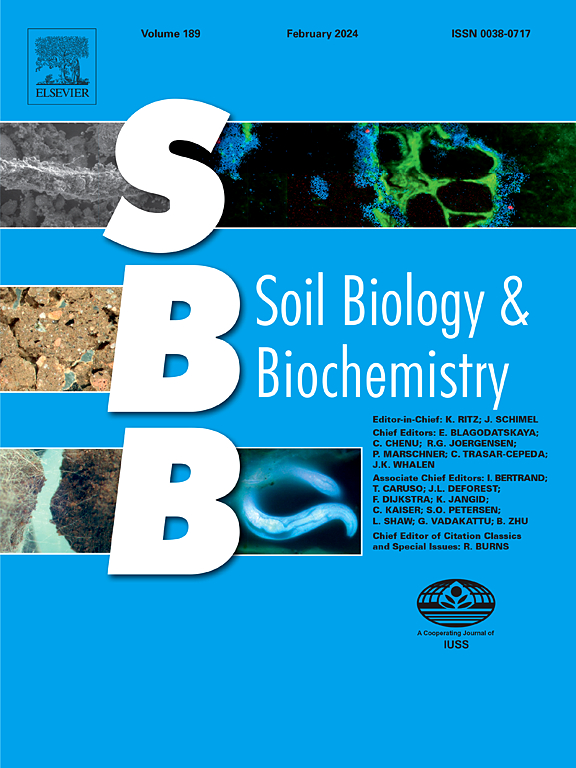The role of earthworms in the transformation of labile plant litter into mineral-associated organic matter
IF 9.8
1区 农林科学
Q1 SOIL SCIENCE
引用次数: 0
Abstract
Although it has been recognized that the formation of organo-mineral complexes may be fostered by soil fauna, their formation pathways are far from understood. The objective of this study was to investigate the processes involved in earthworm-mediated mineral-associated organic matter (MAOM) formation. To this end, we used microcosms to produce casts with three different temperate earthworm species (epigeic Lumbricus castaneus [LC], epi-anecic Lumbricus terrestris [LT], endogeic Aporrectodea icterica [AI]) fed with 13C-enriched Miscanthus litter in two contrasting soil types (Luvisol, Cambisol). To investigate MAOM formation processes, we used 13C isotope tracing to track litter-derived carbon origin and neutral sugar biomarkers to resolve microbial transformation pathways.
Our results indicated that cast MAOM-C concentrations increased compared to the control treatment without earthworms, with LC casts in Luvisol exhibiting the highest MAOM-C concentration (24.1 mg g−1). MAOM-C contribution to casts decreased in the order LC > LT > AI. Sugar biomarkers revealed species- and soil-dependent stabilization pathways: MAOM of LC casts in Luvisol contained high proportions of plant-derived arabinose, while MAOM of AI casts in Cambisol were enriched in microbial-derived hexoses (mannose) and deoxy-hexoses (rhamnose, fucose). We conclude that earthworms depending on species and soil type accelerated MAOM formation via synergistic pathways: (1) direct stabilization of plant sugars and (2) microbial transformation of labile litter into necromass during cast formation. We suggest that earthworm-driven MAOM formation depends on species-specific traits (e.g., LC's capacity for litter fragmentation) and soil properties (e.g., clay and CaCO3 content).
蚯蚓在将不稳定的植物凋落物转化为稳定的矿物相关有机物中的作用
虽然已经认识到有机-矿物复合体的形成可能由土壤动物促进,但其形成途径尚不清楚。本研究的目的是研究蚯蚓介导的矿物相关有机质(MAOM)形成的强度和过程。为此,我们在两种不同的土壤类型(Luvisol, Cambisol)中,用三种不同的温带蚯蚓(表生蚓(epigeic Lumbricus castaneus) [LC],表生蚓(epi-anecic Lumbricus terrestris) [LT],内源Aporrectodea icterica [AI])饲喂富含13c的Miscanthus凋落物,用微型模型生产了铸体。为了研究MAOM的形成过程,我们使用13C同位素示踪来跟踪凋落物碳源和中性糖生物标志物来解决微生物转化途径。结果表明,与不含蚯蚓的对照处理相比,Luvisol中LC铸体的MAOM-C含量增加,MAOM-C浓度最高(24.1 mg g-1)。MAOM-C对铸模的贡献按LC >的顺序递减;LT祝辞人工智能。糖生物标志物揭示了物种和土壤依赖的稳定途径:Luvisol中LC铸模的MAOM含有高比例的植物来源阿拉伯糖,而Cambisol中AI铸模的MAOM富含微生物来源的己糖(甘露糖)和脱氧己糖(鼠李糖,焦糖)。我们得出结论,蚯蚓根据物种和土壤类型的不同,通过以下协同途径加速MAOM的形成:(1)直接稳定植物糖;(2)在cast形成过程中微生物将不稳定凋落物转化为坏死块。我们认为,蚯蚓驱动的MAOM形成取决于物种特异性特征(如LC的凋落物破碎能力)和土壤性质(如粘土和钙含量)。
本文章由计算机程序翻译,如有差异,请以英文原文为准。
求助全文
约1分钟内获得全文
求助全文
来源期刊

Soil Biology & Biochemistry
农林科学-土壤科学
CiteScore
16.90
自引率
9.30%
发文量
312
审稿时长
49 days
期刊介绍:
Soil Biology & Biochemistry publishes original research articles of international significance focusing on biological processes in soil and their applications to soil and environmental quality. Major topics include the ecology and biochemical processes of soil organisms, their effects on the environment, and interactions with plants. The journal also welcomes state-of-the-art reviews and discussions on contemporary research in soil biology and biochemistry.
 求助内容:
求助内容: 应助结果提醒方式:
应助结果提醒方式:


